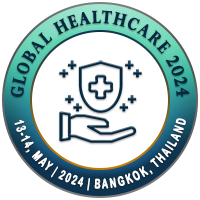.jpg)
Gerald C Hsu
Eclaire MD Foundation, USATitle: Quantitative evidence of ultimate benefit on lifespan extension starting from lifestyle management through chronic disease and several deadly complications toward longevity using collected data between Y2014 and Y2022 while applying the space-domain energy model of viscoplastic medicine theory for 6 separated but inter-connected analysis cases based on GH-Method: Math-physical medicine
Abstract
Since 2010, the author has practiced a lifestyle of choosing high-quality food from the mediterranean diet, including fresh vegetables & fruits, nuts & seeds, fish, tofu, cheese, and olive oil, while avoiding red meat, processed foods, unhealthy snacks, and sugary food. He also controlled the food portion size around 50% to 75% of his earlier food consumption level prior to Y2010 (using as the 100% yardstick). He walks about 7 miles (10 km or 16,000 steps) each day, including 4,000 steps after each meal. In addition, he also practices Chinese Tai-chi movement and arms/leg stretching. He maintains 7-8 hours of sleep with minimal or no interruption, such as night-time urination. He avoids stressful events or incidents as much as possible and practices meditation from time to time.
As a result, a comparison of his health improvements between Y2010 and Y 2022 are: Body weight reduces from 220 lbs (110 kg) to 165 lbs (75 kg), waistline from 46 inch (117 cm) to 33 inch (84 cm), daily glucose from 280 mg/dL to 103 mg/dL, fasting glucose from 180 mg/dL to 86 mg/dL, HbA1C from 11% to 5.8%. He stopped taking diabetes medications since 12/8/2015. His blood pressure and cholesterols are also turned into normal. This article discusses specifically the sequential benefits of every single health stage of his life dire to his stringent lifestyle management efforts, starting from obesity through diabetes, hypertension, hyperlipidemia, cardiovascular diseases, kidney damage, neuropathy, retinopathy, foot ulcer, and finally to his longevity goal.
Other than the fundamental genetic factors and certain external environmental factors, when people do not pay attention to their lifestyle details, such as overeating, having a poor diet, lack of exercise, high stress, and sleep loss along with having certain long-term unhealthy habits (cigarettes smoking, alcohol drinking, and illicit drugs use), they are likely to gain body weight as the first sign of health problems. For most cases, being overweight and having obesity develop into diabetes conditions. When excessive glucose circulates in the bloodstream, it causes damage to the structural integrity of the arteries and even to some micro-vessels. In addition, high Blood Pressure (BP) would easily create an artery rupture situation, and high cholesterol would cause an artery blockage situation through plaque build-up. Combining these three biomarkers, glucose, blood pressure, and blood lipids (cholesterol), we could determine the overall risk probability of a chronic disease patient’s chance of developing strokes, CardioVascular Disease (CVD), or Chronic Kidney Disease (CKD). When combined with long-term unhealthy habits, mainly cigarette smoking, with these 6 poor lifestyle categories, diet, water intake, exercise, sleep, stress, regular life routines (an essential part of all medical fields, whether traditional medicine or western medicine), it would eventually increase the risk of developing certain cancers. These mortality threats, including CVD, Strokes, CKD, and cancers, would count for more than half of total death cases in the US and the world. These metabolic diseases plus immunity-related infectious diseases would count for about 80% to 85% of total death each year. After all, improving metabolism and strengthening immunity are the basic 2 cornerstones to avoiding mortality and prolonging the lifespan.
In this article, the author selects the top three influential factors for each of these 5 somewhat related diseases, obesity, diabetes, CVD/Strokes, CKD, and cancers, to investigate the connection diagram or roadmap and their ultimate impact on expected lifespan, i.e., longevity.
In addition, he has chosen the Space-Domain Viscoplastic Medicine Theory (SD-VMT) energy model to calculate individual energies (or degree of influence or degree of contribution) associated with 3 individual input stress components concerning the single output strain. These 6 sets of complicated calculations have utilized the developed VMT module of his chronic research software on his iPhone device.
Biography
Gerald C Hsu received an honourable Ph.D. in mathematics and majored in engineering at MIT. He attended different universities over 17 years and studied seven academic disciplines. He has spent 20,000 hours in T2D research. First, he studied six metabolic diseases and food nutrition during 2010-2013, then conducted research during 2014-2018. His approach is “math-physics and quantitative medicine” based on mathematics, physics, engineering modelling, signal processing, computer science, big data analytics, statistics, machine learning, and AI. His main focus is on preventive medicine using prediction tools. He believes that the better the prediction, the more control you have.

